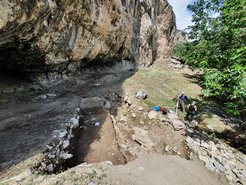Caves and Rock Shelters of Central Asia: Time Capsules of Human Behavior
Caves and rock shelters have attracted humans for hundreds of thousands of years. The well-preserved sediments within these natural time capsules provide detailed environmental, paleontological, and archaeological information. The Tian Shan and Pamir mountains have been an important corridor of human movement between Central and East Asia throughout the Quaternary. Studies of caves and rock shelters located at various elevations and covering a broad time span are clarifying many pressing issues in Central Asian archaeology, including what the routes of dispersal for plants and animals looked like, the evolutionary changes of those organisms over time, and the dynamics of prehistoric cultural change.

This project is studying archaeobotanical remains recovered from four recently excavated cave sites in Central Asia – Obishir-5, Surungur, Sel’Ungur, Istikskaya, and Kurteke. The Obishir-5, Sel’Ungur and Surungur sites are located in the southern part of the Ferghana Valley, Kyrgyzstan – a crossroads between the western steppe and high mountain regions. The Istikskaya and the Kurteke sites provide insights into the archaeology of high-elevation mountain occupations in the Pamir Mountains of Tajikistan. The team seeks to reconstruct cooking habits, to trace possible trade and exchange relations with neighboring territories, to learn about the timing of intentional cultivation of plants in Kyrgyzstan and Tajikistan, to have insights into interactions between changing environmental conditions and the everyday lives of people (e.g. fuel choices, plant availability) throughout the Holocene. Our collaborators from Kyrgyzstan, Russia, and Tajikistan are essential members of the project.
